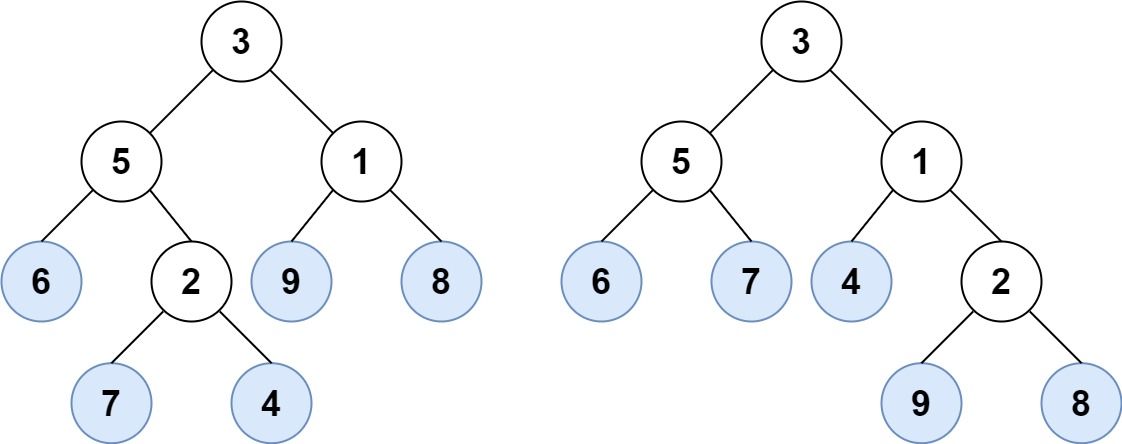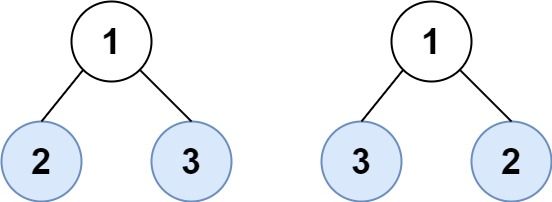Consider all the leaves of a binary tree, from left to right order, the values of those leaves form a leaf value sequence.
For example, in the given tree above, the leaf value sequence is (6, 7, 4, 9, 8).
Two binary trees are considered leaf-similar if their leaf value sequence is the same.
Return true if and only if the two given trees with head nodes root1 and root2 are leaf-similar.
Example 1:
Input: root1 = [3,5,1,6,2,9,8,null,null,7,4], root2 = [3,5,1,6,7,4,2,null,null,null,null,null,null,9,8] Output: true
Example 2:
Input: root1 = [1,2,3], root2 = [1,3,2] Output: false
Constraints:
- The number of nodes in each tree will be in the range
[1, 200]. - Both of the given trees will have values in the range
[0, 200].
# Definition for a binary tree node.
# class TreeNode:
# def __init__(self, val=0, left=None, right=None):
# self.val = val
# self.left = left
# self.right = right
class Solution:
def leafSimilar(self, root1: Optional[TreeNode], root2: Optional[TreeNode]) -> bool:
def dfs(root):
if root is None:
return []
ans = dfs(root.left) + dfs(root.right)
return ans or [root.val]
return dfs(root1) == dfs(root2)/**
* Definition for a binary tree node.
* public class TreeNode {
* int val;
* TreeNode left;
* TreeNode right;
* TreeNode() {}
* TreeNode(int val) { this.val = val; }
* TreeNode(int val, TreeNode left, TreeNode right) {
* this.val = val;
* this.left = left;
* this.right = right;
* }
* }
*/
class Solution {
public boolean leafSimilar(TreeNode root1, TreeNode root2) {
List<Integer> l1 = dfs(root1);
List<Integer> l2 = dfs(root2);
return l1.equals(l2);
}
private List<Integer> dfs(TreeNode root) {
if (root == null) {
return new ArrayList<>();
}
List<Integer> ans = dfs(root.left);
ans.addAll(dfs(root.right));
if (ans.isEmpty()) {
ans.add(root.val);
}
return ans;
}
}/**
* Definition for a binary tree node.
* struct TreeNode {
* int val;
* TreeNode *left;
* TreeNode *right;
* TreeNode() : val(0), left(nullptr), right(nullptr) {}
* TreeNode(int x) : val(x), left(nullptr), right(nullptr) {}
* TreeNode(int x, TreeNode *left, TreeNode *right) : val(x), left(left), right(right) {}
* };
*/
class Solution {
public:
bool leafSimilar(TreeNode* root1, TreeNode* root2) {
return dfs(root1) == dfs(root2);
}
vector<int> dfs(TreeNode* root) {
if (!root) return {};
auto ans = dfs(root->left);
auto right = dfs(root->right);
ans.insert(ans.end(), right.begin(), right.end());
if (ans.empty()) ans.push_back(root->val);
return ans;
}
};/**
* Definition for a binary tree node.
* type TreeNode struct {
* Val int
* Left *TreeNode
* Right *TreeNode
* }
*/
func leafSimilar(root1 *TreeNode, root2 *TreeNode) bool {
var dfs func(*TreeNode) []int
dfs = func(root *TreeNode) []int {
if root == nil {
return []int{}
}
ans := dfs(root.Left)
ans = append(ans, dfs(root.Right)...)
if len(ans) == 0 {
ans = append(ans, root.Val)
}
return ans
}
return reflect.DeepEqual(dfs(root1), dfs(root2))
}


